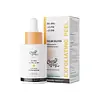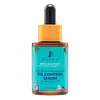What's inside
What's inside
 Key Ingredients
Key Ingredients

 Benefits
Benefits

 Concerns
Concerns

 Ingredients Side-by-side
Ingredients Side-by-side

Water
Skin ConditioningGlycolic Acid
BufferingLactic Acid
BufferingMandelic Acid
AntimicrobialPropylene Glycol
HumectantLactobionic Acid
BufferingSodium Hydroxide
BufferingPropanediol
SolventSodium Salicylate
PreservativePolyquaternium-39
Phenoxyethanol
PreservativeHibiscus Sabdariffa Flower Extract
Skin ConditioningAllantoin
Skin ConditioningCeramide Ag
HumectantOryza Sativa Cera
Skin ConditioningAloe Barbadensis Leaf Extract
EmollientXanthan Gum
EmulsifyingPhenethyl Alcohol
MaskingSodium Hyaluronate
HumectantButeth-3
SolventDisodium EDTA
Sodium Benzotriazolyl Butylphenol Sulfonate
UV AbsorberChamomilla Recutita Flower Extract
MaskingTributyl Citrate
SolventPhospholipids
Skin ConditioningSphingolipids
EmollientMaltodextrin
AbsorbentWater, Glycolic Acid, Lactic Acid, Mandelic Acid, Propylene Glycol, Lactobionic Acid, Sodium Hydroxide, Propanediol, Sodium Salicylate, Polyquaternium-39, Phenoxyethanol, Hibiscus Sabdariffa Flower Extract, Allantoin, Ceramide Ag, Oryza Sativa Cera, Aloe Barbadensis Leaf Extract, Xanthan Gum, Phenethyl Alcohol, Sodium Hyaluronate, Buteth-3, Disodium EDTA, Sodium Benzotriazolyl Butylphenol Sulfonate, Chamomilla Recutita Flower Extract, Tributyl Citrate, Phospholipids, Sphingolipids, Maltodextrin
Water
Skin ConditioningNiacinamide
SmoothingSalicylic Acid
MaskingPropanediol
SolventCamellia Sinensis Extract
AntioxidantMelia Azadirachta Extract
Skin ConditioningSalix Alba Bark Extract
AstringentAloe Barbadensis Leaf Extract
EmollientSodium Lactate
BufferingSodium Gluconate
Skin ConditioningBetaine
HumectantPhenoxyethanol
PreservativeEthylhexylglycerin
Skin ConditioningSodium Hyaluronate
HumectantPanthenol
Skin ConditioningSodium Benzoate
MaskingPotassium Sorbate
PreservativeHeptyl Glucoside
Hydroxyethyl Urea
HumectantXanthan Gum
EmulsifyingAllantoin
Skin ConditioningMelaleuca Alternifolia Leaf Oil
AntioxidantTocopheryl Acetate
AntioxidantWater, Niacinamide, Salicylic Acid, Propanediol, Camellia Sinensis Extract, Melia Azadirachta Extract, Salix Alba Bark Extract, Aloe Barbadensis Leaf Extract, Sodium Lactate, Sodium Gluconate, Betaine, Phenoxyethanol, Ethylhexylglycerin, Sodium Hyaluronate, Panthenol, Sodium Benzoate, Potassium Sorbate, Heptyl Glucoside, Hydroxyethyl Urea, Xanthan Gum, Allantoin, Melaleuca Alternifolia Leaf Oil, Tocopheryl Acetate
Ingredients Explained
These ingredients are found in both products.
Ingredients higher up in an ingredient list are typically present in a larger amount.
Allantoin is a soothing ingredient known for its protective and moisturizingg properties. Because of this, it is often added to products with strong active ingredients.
Studies show higher concentrations of this ingredient can promote wound healing.
Though it can be derived from the comfrey plant, allantoin is produced synthetically for cosmetic products to ensure purity.
Learn more about AllantoinAloe Barbadensis Leaf Extract is an extract of the leaves of the aloe, Aloe barbadensis, Liliaceae.
Aloe is one of the most well-known natural soothing ingredients, and for good reason. It’s full of water and has a cooling, calming effect on the skin, especially when it’s sunburned, itchy, or irritated. Aloe also helps your skin stay hydrated and smooth by mimicking what healthy skin naturally produces. On top of that, it contains vitamins and nutrients that support skin recovery.
It doesn’t protect you from the sun, but it can help your skin bounce back after too much time in it.
Let’s get into the details:
Aloe contains antioxidant Vitamins A, C, and E, which help fight off free radicals (unstable molecules from things like pollution that can damage your skin).
It’s also rich in polysaccharides, which are natural sugars that help hydrate the skin by acting like the skin’s own moisturizing agents. These, along with other sugars like monosaccharides, help form a protective barrier that locks in moisture.
Aloe works as both a humectant and an emollient. That means it draws water into the skin (humectant) and helps trap it there (emollient), making it an effective natural moisturizer.
You’ll also find a mix of other skin-supporting ingredients in aloe, including folic acid, choline, calcium, amino acids, fatty acids, and even Vitamin B12.
Out of the 420+ species of aloe, Aloe barbadensis is the most widely used in skincare products thanks to its gentle yet effective properties.
There are over 420 species of aloe but Aloe Barbadensis is the most commonly used for topical products.
Learn more about Aloe Barbadensis Leaf ExtractPhenoxyethanol is a preservative that has germicide, antimicrobial, and aromatic properties. Studies show that phenoxyethanol can prevent microbial growth. By itself, it has a scent that is similar to that of a rose.
It's often used in formulations along with Caprylyl Glycol to preserve the shelf life of products.
Propanediol is an all-star ingredient. It softens, hydrates, and smooths the skin.
It’s often used to:
Propanediol is not likely to cause sensitivity and considered safe to use. It is derived from corn or petroleum with a clear color and no scent.
Learn more about PropanediolSodium Hyaluronate is hyaluronic acid's salt form. It is commonly derived from the sodium salt of hyaluronic acid.
Like hyaluronic acid, it is great at holding water and acts as a humectant. This makes it a great skin hydrating ingredient.
Sodium Hyaluronate is naturally occurring in our bodies and is mostly found in eye fluid and joints.
These are some other common types of Hyaluronic Acid:
Learn more about Sodium HyaluronateWater. It's the most common cosmetic ingredient of all. You'll usually see it at the top of ingredient lists, meaning that it makes up the largest part of the product.
So why is it so popular? Water most often acts as a solvent - this means that it helps dissolve other ingredients into the formulation.
You'll also recognize water as that liquid we all need to stay alive. If you see this, drink a glass of water. Stay hydrated!
Learn more about WaterXanthan gum is used as a stabilizer and thickener within cosmetic products. It helps give products a sticky, thick feeling - preventing them from being too runny.
On the technical side of things, xanthan gum is a polysaccharide - a combination consisting of multiple sugar molecules bonded together.
Xanthan gum is a pretty common and great ingredient. It is a natural, non-toxic, non-irritating ingredient that is also commonly used in food products.
Learn more about Xanthan Gum